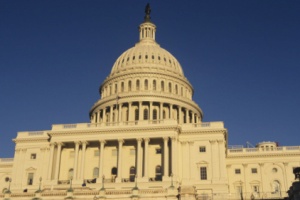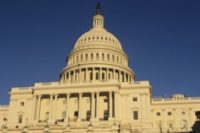 A government watchdog group says that anti-regulation lawmakers used procedural hurdles and attacks on science to block new federal laws standards in 2012 - and that they're likely to continue that strategy in the coming year. "Both efforts are likely to re-emerge next year,” predicts OMB Watch, a nonprofit research and advocacy organization that monitors actions by the White House Office of Management and Budget (OMB).
A government watchdog group says that anti-regulation lawmakers used procedural hurdles and attacks on science to block new federal laws standards in 2012 - and that they're likely to continue that strategy in the coming year. "Both efforts are likely to re-emerge next year,” predicts OMB Watch, a nonprofit research and advocacy organization that monitors actions by the White House Office of Management and Budget (OMB).
A Regulatory Freeze
OMB Watch points to the the "Red Tape Reduction and Small Business Job Creation Act," passed by the Republican-controlled House of Representatives in July. The measure is nicknamed "the regnibus" because it comprises seven different pieces of anti-regulatory legislation. The most prominent of the bills was the so-called "Regulatory Freeze for Jobs Act," which would prohibit any new rules until the unemployment rate falls and stays below six percent.
The House also passed a package of bills on Sept. 21 that OMB Watch characterizes as “anti-environmental.” The collection, known as the "Stop the War on Coal Act of 2012," was comprised of five measures (four of which had already passed the House) that would limit the EPA’s ability to regulate coal ash or to limit greenhouse gas emissions. The package also included the "Transparency in Regulatory Analysis of Impacts on the Nation (TRAIN) Act" (H.R. 2401), which would require that an interagency panel of non-experts review any EPA regulations before they are issued and submit a report to Congress on the costs of proposed regulations.
The Democratic-controlled Senate took no action on any of the anti-regulatory measures.
OMB Watch pointed to the Independent Agency Regulatory Analysis Act (S. 3468) as a regulatory-delaying bill that could gain traction in 2013. Introduced on Aug. 1 of this year by Sens. Mark Warner (D-VA), Rob Portman (R-OH), and Susan Collins (R-ME), the measure would require independent regulatory agencies to complete detailed cost-benefit analyses before proposing a rule and would empower the Office of Information and Regulatory Affairs (OIRA) to review and delay rules proposed by independent agencies.
“The legislation seemed headed straight to mark-up within the Senate's Homeland Security and Governmental Affairs Committee (HSGAC) until a massive public education campaign by advocates and commissioners of independent agencies stopped its movement.,” said OMB Watch.
While the bill's supporters presented it as a noncontroversial ‘process" bill,’ a number of independent agency regulators wrote that the bill "would interfere with our ability to promulgate rules critical to our missions in a timely manner and would likely result in unnecessary and unwarranted litigation in connection with our rules."1
Among the agencies impacted are those charged with oversight of the banking and financial industry, such as the Securities and Exchange Commission (SEC), and the Consumer Product Safety Commission (CPSC), which is responsible for ensuring the safety of consumer products and children's toys.
Delays and Setbacks
Amid speculation that delays were intended to avoid controversy during the election season, rules like OSHA’s bid to strengthen crystalline silica exposure limits languished on Capitol Hill.
One long-delayed rule is an effort by the Occupational Safety and Health Administration (OSHA) to strengthen workplace exposure limits for crystalline silica, a known cause of lung cancer and disabling respiratory illness. The rule regarding silica -- a known cause of lung cancer and disabling respiratory illness -- has been at the Office of Information and Regulatory Affairs (OIRA) since Feb. 14, 2011 – almost two years. During this time, OSHA estimates that more than 100 workers have died from silica-related illnesses.
“This unreasonable delay occurred after OIRA held a number of closed-door meetings with industry groups and sparked a letter from 300 occupational health experts, public safety advocates, and labor officials, urging President Obama to release the rule for public comment. Almost a year after the letter was sent, the rule remains at OIRA,” says OMB Watch.
Under Executive Order 12866, OIRA review is limited to 90 days with a possible 30-day extension, but rules are routinely delayed beyond the 120-day deadline. An examination of OIRA review counts shows that the average number of days each agency action was under review was significantly higher in 2012 compared to the previous three years.
“Another proposed rule long past due is the U.S. Environmental Protection Agency's (EPA) effort to add toxics to its Chemicals of Concern List. Under the Toxic Substances Control Act (TSCA), EPA is supposed to add chemicals to its list of substances that present (or may present) an unreasonable risk of injury to human health or the environment. The rule is not economically significant and would have important health and safety benefits, yet it has been stalled at OIRA since May 2010. Over a year ago, Sens. Frank Lautenberg (D-NJ) and Sheldon Whitehouse (D-RI) wrote to OIRA asking that the proposed rule be released. OIRA has yet to release the rule or explain the reason for the delay.”
Additionally, three sets of food safety regulations are in apparent limbo at OIRA, even though the Food Safety Modernization Act of 2011 requires the Food and Drug Administration to promulgate the regulations by specific deadlines.
OIRA completed about 390 reviews in 2012 (as of Nov. 30), far fewer than in the past three years. Of those, 77 reviews were related to economically significant rules. The average number of days it took OIRA to review each action increased from 39 days in 2009 to 75 days in 2012. A total of 108 actions have been at OIRA for 120 days or more. Only 21 of these pending actions are economically significant; 87 pending reviews are not economically significant actions.
Science angle
OMB Watch also identifies attacks on scientific analyses conducted or used by agencies as a stall tactic on the part of opponents of regulation.
“Industry interests now routinely challenge agencies' scientific review processes and demand endless rounds of comment and peer review before government agencies can finalize rules preventing health hazards. These processes can take years. In the meantime, people get sick and die as a result of these delays.”
The House hearing in 2012 questioned the quality and integrity of the science EPA uses in regulatory decisions and in cost-benefit analyses, the role of peer reviews and advisory panels in reviewing scientific evidence, as well as the public's perception of EPA's science.
In September, Rep. Ralph Hall (R-TX), Chairman of the House Committee on Science, Space, and Technology, introduced the "EPA Science Advisory Board Reform Act of 2012" (H.R. 6564), which seeks to alter EPA's scientific review processes. This bill would limit the number of government-funded scientists allowed to serve on the EPA's Science Advisory Board (SAB) to 10 percent of the total board membership and prohibit specialized experts involved in a rulemaking, directly or indirectly, from serving on the board.
OMB Watch says the bill would attempt to make industry-funded scientists a majority of the members of the SAB, and would ensure that the the SAB is no longer independent.
“This bill is widely supported by industry trade associations and is likely to reappear in 2013.”
1 In an Oct. 26, 2012, letter to members of HSGAC, Ben Bernanke, Chairman of the Board of Governors of the Federal Reserve System, Mary Schapiro, Chairman of the U.S. Securities and Exchange Commission, and four other financial regulators urged the committee to consider the negative consequences of the bill before moving forward with it. Available at http://www.ombwatch.org/files/regs/financial_regulators_ltr_lieberman_collins_s3468.pdf.




